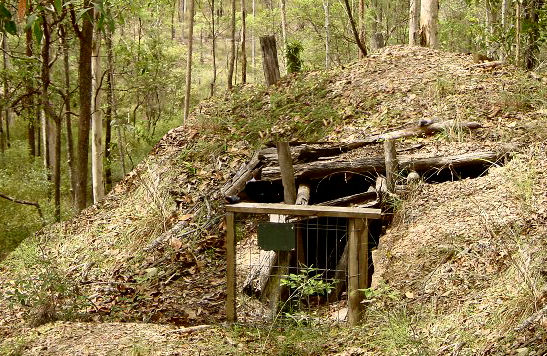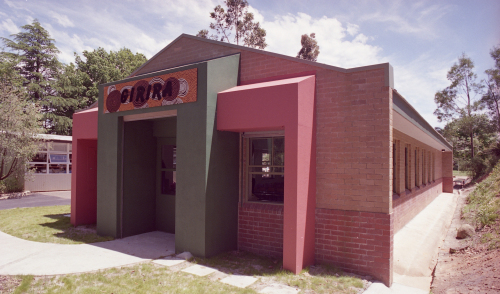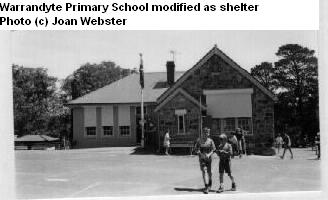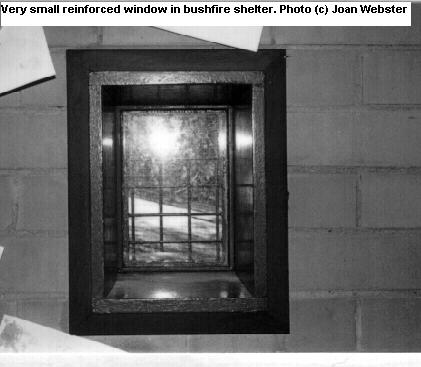
Joan Webster, author of The Complete Bushfire Safety Book and Essential Bushfire Safety Tips believes that some information, contained in the article "Fire bunkers could have helped in the Victorian fires" of 20 Feb 09, is wrong and may put lives at risk. In this article, she explans why.
See also: "Bushfire bunkers strategy an 'after-the-fact' dead end" of 21 Jun 09.
This article, is in response to the article "Fire bunkers could have helped in the Victorian fires" of 10 Feb 09 and comments in reponse to that article.
Hello again. I'm Joan Webster, author of The Complete Bushfire Safety Book (Random House, 2000) and Essential Bushfire Safety Tips (CSIRO 2008). I've been researching and writing about bushfire safety for over 45 years. James asked me to respond to some correspondence on bushfire bunkers, dugouts and tunnels that I saw as misleading in regard to safety issues. Some are dangerous. Others absurd.
The subject matter is dotted, bolded and underlined. Correspondents' comments are dotted and bolded and put in quote marks. My response is preceded by my initials, JW, underlined. (I have turned them into headings with links back to the the ealier article. - JS)
The 1900s timber mill bunkers
JW: Those shown in the photographs would be death traps. For one thing, look at the flammable matter around and in them! It was even suggested they be 'covered with logs'.

All undergrowth and litter needs to be cleared around and above them for at least 30 metres, and trees for the distance of at least twice their mature height - in case they fall. Another big problem with dugouts such as those in the photos is that timber and corrugated iron can rot and rust after long contact with earth, and that many timber preservatives are highly flammable.
Those built by the Forests Commission in the 1920s for timber mill workers, the large, well-constructed ones, equipped with solid doors, plenty of water, wetted nose covers and pure wool blankets saved many lives. But in others, many, many people died. These, of the type described on February 10th, as 'simply a ditch dug 3 or 4 foot into the ground … and 2 foot of earth piled on top', were shallow and too small for the number of people sheltering in them. The people huddling in them died of smoke inhalation, asphyxiation, dehydration and heat exhaustion.
Bushfire shelters of any description need to be roomy enough for the number of people who use them. Crowding will not only quickly use up the oxygen in the space, but will further heat people already sweltering because of the hot day and heat from nearby bush and house fires. They may faint. They may suffocate. They may dehydrate. At a bushfire a person can lose up to two litres of body fluid an hour by sweating. Unless this is replaced by drinking at least a glass each 10 minutes, the salts and minerals in the blood become imbalanced, those normally excreted build up in the body tissues, kidneys can fail and death quickly follow.
Timber settlement dugouts were not built in the bush after the 1939 tragedies, both because most had not proved to be safe and because the workers' houses were from then on built separated from the bush in which the men worked.
I've attached pictures of some exemplary bushfire shelters purpose built for schools in the Dandenongs in 1988. They were built by the Victorian Education Department after I made a big fuss about the lethal state of officially designated community refuges. The architects used my (then titled) The Complete Bushfire Safety Book Australian Bushfire Book.

Sassafras Primary School Shelter


'The 1900's fire bunkers … (had an) exit at both ends … (so that) cool air enters the open ends'
JW: Any refuge open at two ends will draw through it not only smoke, but embers and flame.
'The way they (dugouts) work is that under the smoke and running along the ground is a two inch layer of cool air. The fire brings it with it to keep burning.'
JW: This is nonsense. A narrow band of less smoky air can be beneath smoke. The fire doesn't 'bring it with it to keep burning'; it is there because hotter air always rises.
'… the fire front passes over the bunker'.
JW: This, too, is nonsense. A fire front will not pass over any properly prepared bunker. Because a fire 'front' is the leading edge of burning vegetation. A properly prepared bunker will have been cleared of vegetation. If you are in a tunnel, dugout or bunker so badly prepared that fire does pass over it, it won't be cool air that enters, it will be smoke.
'You don't need doors or anything fancy'.
JW: Oh, yes, you do. Any bushfire shelter needs a fire-rated solid-core door fitted with an outer, spark-protective, metal-mesh screen and draught stoppers.
Hessian entrance flaps
JW: The suggestion that 'heavy calico or Hessian at the entrance' of a tunnel or dugout is sufficient needs to be counteracted. Certainly, this could stop the rays of radiant heat. But they would not hinder convected heat, the heat of hot wind and air, that can produce body temperature rise with resultant heat exhaustion and/or dehydration.
The inhalation of superheated air may cause rapid swelling of the throat, which can compress the windpipe and cause asphyxiation.
Concrete bunkers
JW: Advertised as being airtight when closed. You would suffocate. As also in the suggested 'simple idea' of a two metre by two metre diameter cement tank, sunk to 2.5 metres. I doubt any 'ventilation access tube' could both let in enough air for life and keep out smoke.
Shipping containers
JW: Used just as they come, you could both suffocate and roast. Think of the recent death of a prisoner transported in a metal-lined van on a day of high air temperature. Like the above-ground concrete cylinders, potential cremation ovens.
Flatpack bunkers
JW: There is no provision for ventilation. You would suffocate. I can't see the elderly, frail or disabled climbing in and out, up and down the ladder.
Cellars under, or immediately adjacent to, the house

JW: Neither are safe. In either situation a burning house could collapse onto it. While in a normal cellar under a house, floorboards above could ignite and trap you, the burning house could collapse onto you. On January 21, 1997, as a severe bushfire in the Dandenong Ranges threatened homes and radio talkback callers phoned in with their fears, I listened with horror as a woman told of her intention to shelter in a cellar. I tried to get on air to warn, but was not put through. That day a young Ferny Creek couple died in their cellar. Their neighbour Genevieve Erin, trying to join them, was found dead nearby. All were buried beneath the smouldering rubble of the collapsed house.
To be a safe refuge a cellar must have a ceiling of reinforced concrete and an external emergency exit well away from the house walls, opening preferably onto flat ground on the leeward, and shielded by radiant heat screens
.
Radiant heat
'Radiant heat travels in straight lines and so passes over the bunker'
.
'(Tunnels) need a turn on them, to avoid the radiant heat, which travels in a straight-line.'
JW: Certainly, the fortunate thing about radiant heat is that it can only travel in straight lines.
But the risk of radiant heat to shelterers is not from heat rays travelling into the bunker. It is from would-be shelterers being hit by radiant heat as they run to it within reach of it from burning vegetation.
The report that a family in a well-constructed tunnel perished because it didn't have a bend in it and 'the radiant heat which travels in a straight line got to them in minutes' sounds like a shaggy-shelter story to me. The zigzag entrances in the tunnels built by the Forests Commission in the 1920s were to keep out smoke. Radiant heat couldn't affect people in a tunnel, bendless or not, unless the tunnel had vegetation flaming close to the entrance and the tunnel was doorless and so shallow that they were exposed to it. It wouldn't 'get to' them if they were wearing 'coverall' clothes - which was very probable in 1939 and 44 bushfires. Remedy: any shelter needs to be well cleared of vegetation and wear protective clothing.
Radiant heat doesn't 'get to' people 'in minutes'. It is in seconds. But you don't need twists and turns in tunnels to avoid it.
One of the simplest lessons to learn about bushfire survival is that almost any material or object will shield you from its deadly rays. Any material, by interrupting and deflecting rays, gives some protection from radiant heat. Pure wool, textured fibreglass, water, earth, buildings, non-flammable walls, tree trunks, embankments, or the body of a person can shield you securely from radiant heat.
Two more simple radiant heat rules are:
- the killer factor of radiant heat is increased by the amount of skin exposed to it, and decreased by the amount of skin hidden from it; and
- the closer you stand to the flames, the more radiant heat reaches you, and the farther you move back the less reaches you. There is a mathematical formula for this: 'the heat transmitted from a single heat source to any point is inversely proportional to the square of its distance from the source'.
The radiant heat emitted by burning vegetation reaches its peak as flames leap highest at a fire front over the surprisingly short period of 60 to 90 seconds, and lessens as the flames move on to fresh fuel - which takes about fifteen minutes. If you can shelter from radiant heat for that short time, you would survive. There is a very basic shelter that has saved countless lives: The pure wool blanket.
The simplest shelter to save you from radiant heat is a heavy duty pure wool blanket. The grey blankets sold at camping and disposal stores are usually of this quality. Have one for each person - and the dog. Carry them in the car with you during summer. Keep them in a handy spot in the house - and you won't need to build either a flawed or a fancy funk hole.
Oxygen can be sucked out shelters, houses, and the air around you during a bushfire.
JW: This doesn't happen during an open fire such as a bushfire. It only happens in enclosed spaces where the burning process uses up a finite amount of air in a finite space. Bushfires consume enormous amounts of oxygen but, as it is used, more rushes in to take its place: this is the cause of a bushfire's selfmade winds. If all the oxygen were sucked out of the air, the fire would go out.
Sandbags: 'How about a cut-out in a bank lined with a layer (or two) of sandbags and a baffle wall of sandbags in front?'
JW: This could seem a good idea at first until you realize that either embers or flames would make short work of the material covering the sandbags. You'd soon have just a pile of loose sand, that would blow away in the strong winds.
Oxygen cylinders in a shelter: 'A cylinder of air (or scuba kit)'.
JW: Think of all the reports of gas cylinders exploding on Black Saturday. The risk with oxygen cylinders could be worse. It is because of the high risk of oxygen cylinders exploding that anything that could spark them - from cigarette smoking to mobile phones are banned in hospitals.
'You simply cannot prepare for a day as bad as that was.'
JW: Oh, yes, you can. And so many did. And because they prepared their houses and their grounds, and their knowledge of what to do, they saved their lives, their homes, and all the precious things within them. They even saved stock and fences.
The time to start preparing for your safety is not on the day of a bushfire nor even at the start of summer. It is now.
Look around your house and sheds; make and mend, paint and fill. Clean out the roof void, install insulation here and under floors; cover chimneys, skylights, gap-boards and windows with metal flywire; perhaps install window shutters; check roofs for loose tiles, loose or holed corrugated iron and eaves for gaps. Prepare screens or shutters for windows. Check out Chapters 8 and 11, 'Design to keep bushfire out of buildings' and 'How to prepare for the bushfire season - Planning ahead', The Complete Bushfire Safety Book or Chapters 14 and 15, 'Planning ahead' and 'Protective chores', Essential Bushfire Safety Tips.
By the way, the idea of window shutters was not Michael Stasse's ('Rebuilding after the bush-fire holocaust'. It was mine. In March, 1983, and subsequently published in my The Complete Australian Bushfire Book (Thomas Nelson, 1986).
Material in this article is © Joan Webster, 2009, and may not be reproduced without written permission.
See also: "Bushfire bunkers strategy an 'after-the-fact' dead end" of 21 Jun 09.

Comments
James Sinnamon
Sun, 2009-06-21 15:07
Permalink
But could we afford the cost of such bushfire shelters?
Thanks, Joan for sharing your knowledge with us.
Aime's article suggested that good protection against bushfires could be achieved at a cost that would be affordable to most people. Yours suggests that the solutions proposed in Aime's article and associated comments could become death traps.
Could I put to you that the bushfire bunker designs she suggested may still be considerably better than no protection at all?
Whether or not this proves to be the case, it seems that the cost, in economic and ecological terms, of giving everyone in bushfire-prone areas near absolute protection against the threat of bushfires may be more than we can afford if we take into account the cost of building bushfire shelters and the clearing of vegetation from around the bushfire shelters.
If we multiply the necessary cleared land per shelter by the number of shelters necessary to house the growing numbers of people living in bushfire-prone areas, whether by choice or necessity, then much more of Australia will necessarily become drier increasing even further the likelihood of bushfires in what little bush is likley to remain.
It is somewhat analogous to the way the waste heat necessarily created by the operation of air-conditioning units in cities like Tokyo actually increases the overall temperature as well as adding to the level of greenhouse gases, even as they afford some respite from the heat inside dwellings.
Instead of going to all this enormous expense and trouble, either as individuals or as a community, we, perhaps, instead, need to consider other alternatives, some of which have already been suggested by others including Tigerquoll in his article "Bushfire bunkers strategy an 'after-the-fact' dead end". These include:
Sheila Newman
Tue, 2009-06-23 22:31
Permalink
Bushfire bunkers past and present
Anonymous (not verified)
Thu, 2014-07-10 01:25
Permalink
A little late commenting on
Anonymous (not verified)
Fri, 2015-01-30 03:59
Permalink
air and oxygen cylinders
Add comment